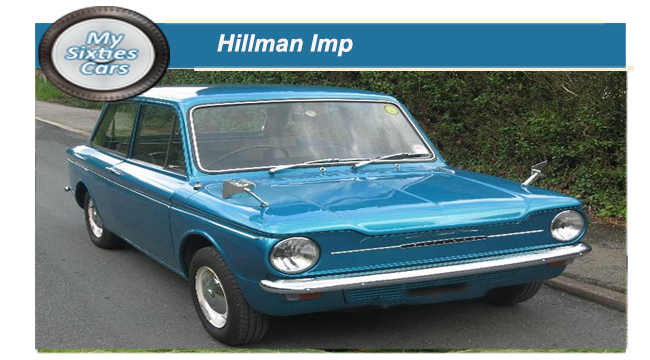
The Mini’s success spurred the other leading UK manufacturers to attempt to emulate its success.
T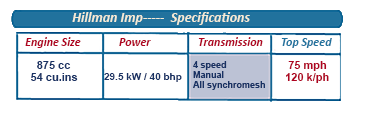 he Rootes Group, who were already lagging behind their opposition across the board, decided that they too had to get their share of the compact car sector.
he Rootes Group, who were already lagging behind their opposition across the board, decided that they too had to get their share of the compact car sector.
Unfortunately, Rootes’ existing production facilities were in no way suitable, and they set up in search of a site response was the Hillman Imp, which appeared in 1963.
This adventure represented a considerable gamble for Rootes who had the most minimal experience in small-car production.
Add to that the fact that their new mini, to be named the Imp, required an entirely new production unit, as further development at the company's Ryton base was impossible.
The chosen site was the small town of Linwood, on the outskirts of Glasgow, Scotland.
B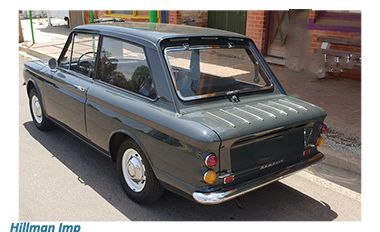 efore the first wheel was turned, the site’s situation presented major logistic problems for Rootes as it necessitated a long and arduous 600 mile ( 950 km) round-trips for parts finished at the main Rootes plant in Ryton -on-Dunsmore in Warwickshire to Central Scotland.
efore the first wheel was turned, the site’s situation presented major logistic problems for Rootes as it necessitated a long and arduous 600 mile ( 950 km) round-trips for parts finished at the main Rootes plant in Ryton -on-Dunsmore in Warwickshire to Central Scotland.
Rootes did have the good sense to ensure that a direct railway link be established between the two plants before production got underway. Even then, the costs involved were considerable.
The arrival of the Imp was greeted with great fanfare, as it was the first (and last) vehicle to be produced in Scotland.
![]()
This was made possible thanks to the UK government ploughing in millions to find employment for the thousands of engineers and other production workers in Central Scotland.
This workforce was available as most were rapidly being made redundant as the Glasgow shipyards closed down one after the other.
R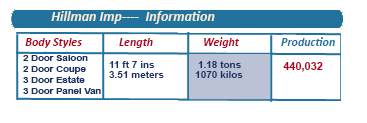 ootes soon discovered, however, that shipbuilders don’t necessarily make good car production workers, meaning that the early Imps were plagued with reliability problems which lost it valuable ground against the competition and indelibly tarnished its reputation — unfairly, because, in the long run, the Imp was a superior car to many of the compacts around in the early to mid-Sixties.
ootes soon discovered, however, that shipbuilders don’t necessarily make good car production workers, meaning that the early Imps were plagued with reliability problems which lost it valuable ground against the competition and indelibly tarnished its reputation — unfairly, because, in the long run, the Imp was a superior car to many of the compacts around in the early to mid-Sixties.
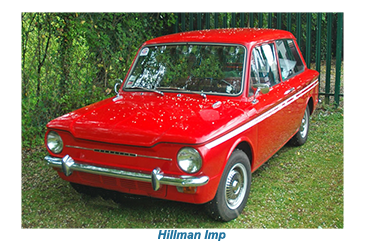 The Imp's Coventry Climax engine was produced in alloy, meaning that it weighed very little and was surprisingly lively.
The Imp's Coventry Climax engine was produced in alloy, meaning that it weighed very little and was surprisingly lively.
The engine was mounted behind the rear wheels and this required sophisticated rear suspension to counteract an inevitable tendency to oversteer.
The original Imp, was powered by an 875 cc straight-4 overhead camshaft engine, matched up to 4-speed manual all-synchromesh gearbox.
I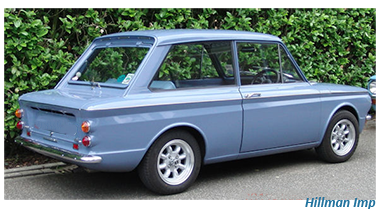 nitially available as a two-door saloon with a rear hatch, in 1965, Rootes decided to cash in on the wave of the Imp's initial success to add a coupe.
nitially available as a two-door saloon with a rear hatch, in 1965, Rootes decided to cash in on the wave of the Imp's initial success to add a coupe.
That same year, Hillman introduced a much better appointed Super Imp version, with its coupe equivalent, the Imp Californian following two years later.
In true brand engineering style, in 1967 Rootes soon whipped up two other coupe options, the Singer Chamois and the Sunbeam Stiletto.
![]()
Squeezing so many options out of a single model was undoubtedly a sterling effort from Rootes.
Unfortunately, their arrival did not help the bottom line, and the Linwood plant continued to lose money at ever increasing levels.
W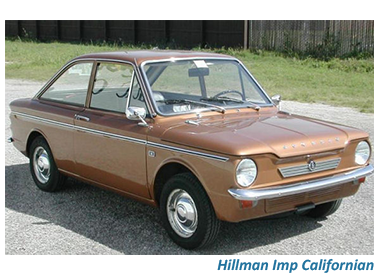 ith Chrysler now involved, most of these “peripheral models” were dropped, a few of them only in production for three or four years.
ith Chrysler now involved, most of these “peripheral models” were dropped, a few of them only in production for three or four years.
The Imp, with its many technical innovations, should have become more than a match for the Mini although, if truth be told, it never really captured the imagination of the UK car-buying public.
The Hillman Imp was eventually discontinued in 1976 after around 440,000 produced.
Chrysler sold out their UK operations to Peugeot in 1987 who closed down and eventually had the Linwood plant demolished – making the plant, that once offered so much promise, possibly the biggest white elephant in the history of the UK car industry.






